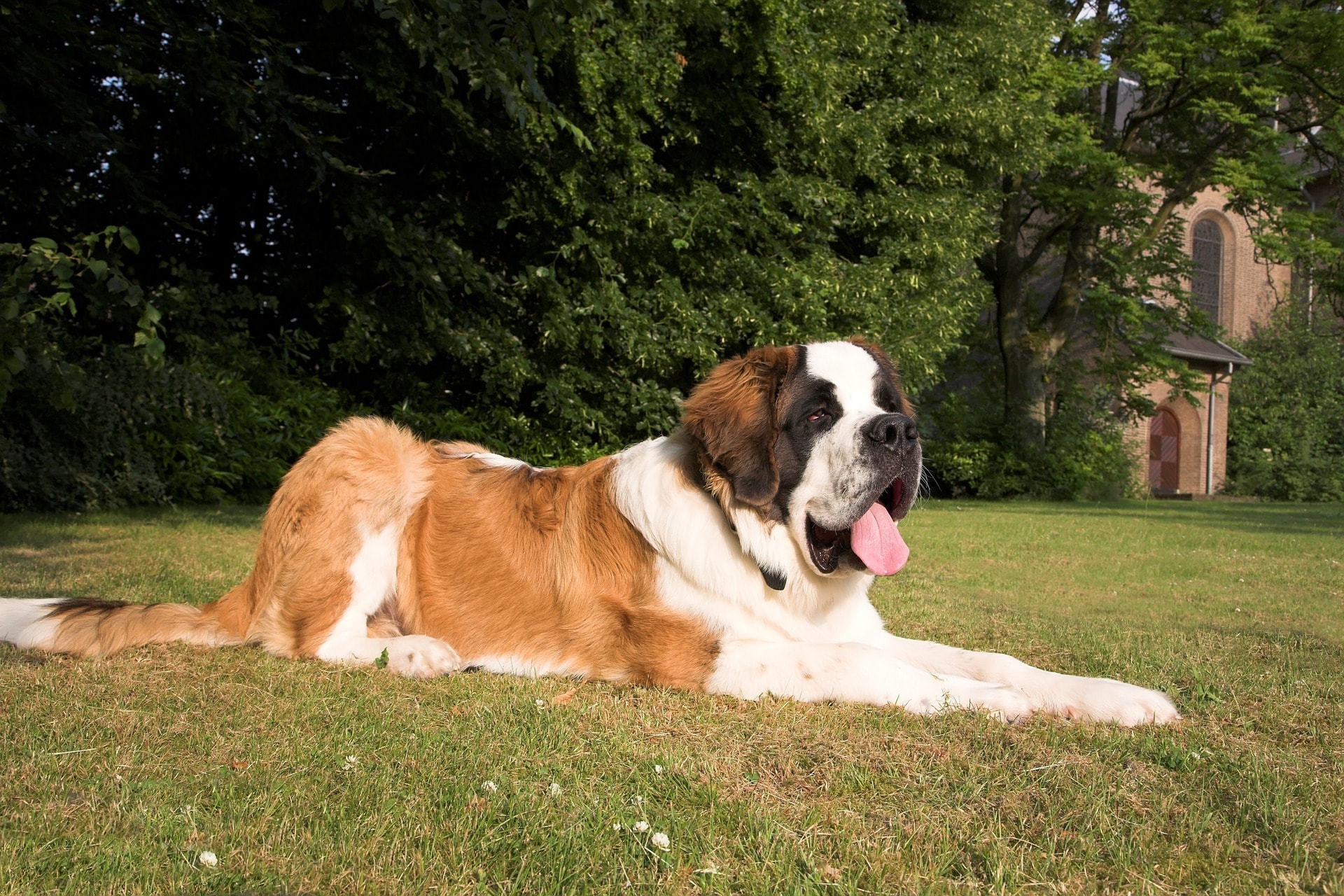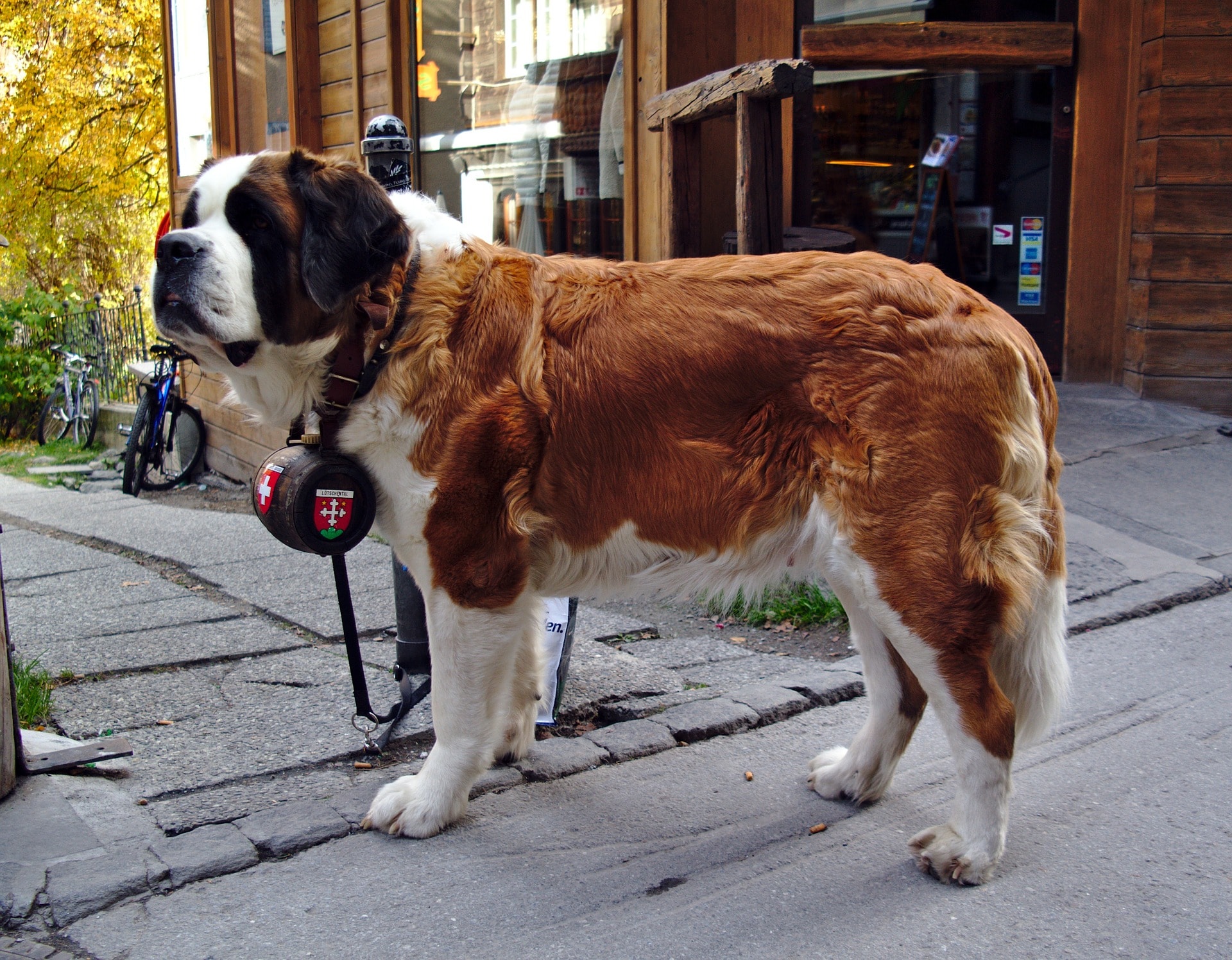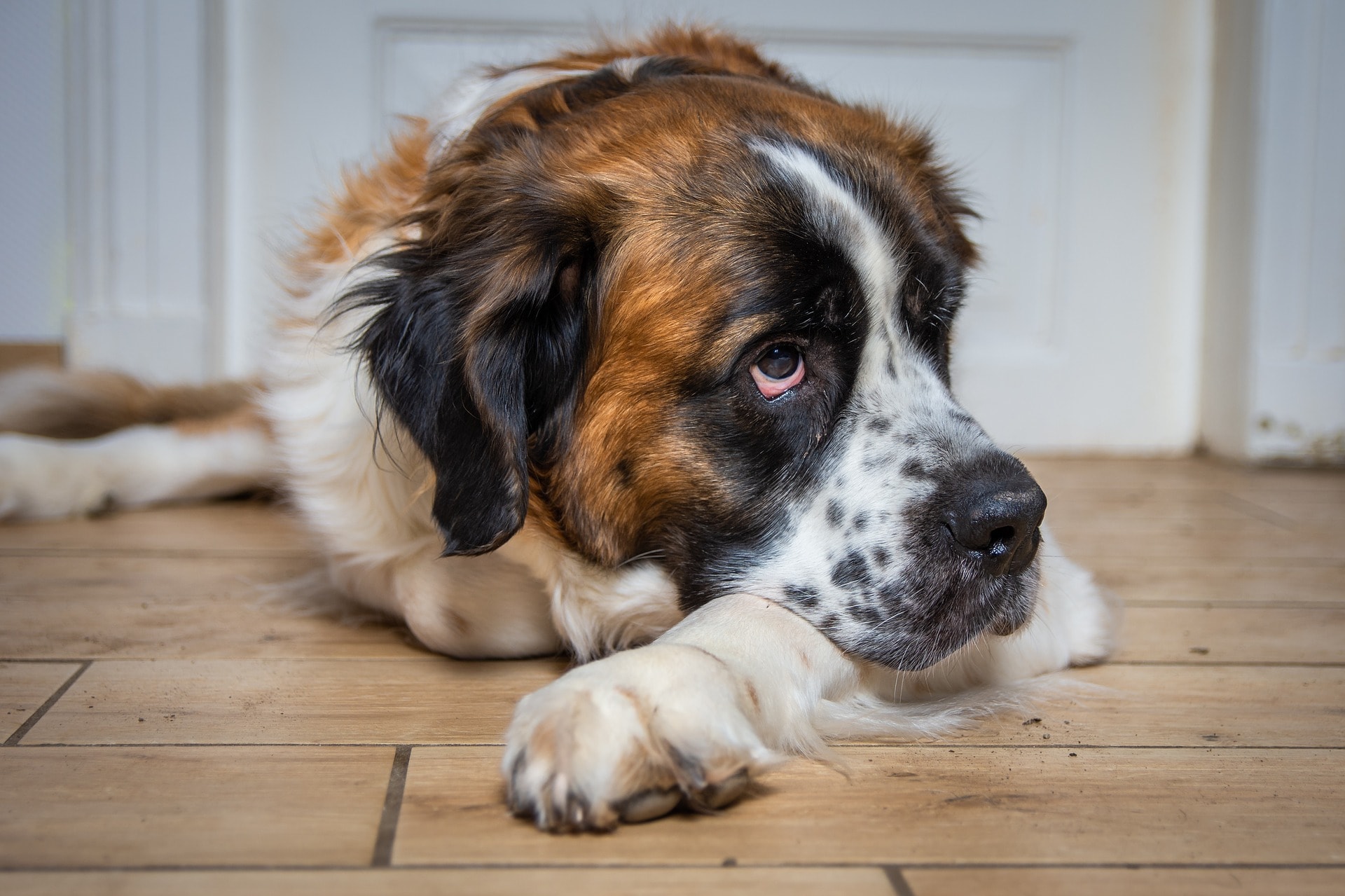
Saint Bernard
Saint Bernard is a playful, charming, and inquisitive dog breed. This dog is one of the world's most famous and beloved dog breeds. Beethoven was the name of the movie that made this dog breed widely popular. Other names for these dogs are St. Bernhardog, Bernhardinner, and Alpine Mastiff. Although they look dangerous they are calm, tolerant, and adaptable dogs who can become great family dogs if you put in the time for training and socialization. Before you start searching Saint Bernard breeders we advise you to explore this breed so you can be sure that you made the right choice when selecting St. Bernard. If you are a neat person, this dog may not be a good choice for you because they will drool and they are heavy shedders. Because they were bred to withstand cold temperatures of the Alps, these dogs don’t like hot weather.
FUN FACT: Saint Bernard is Switzerland's national dog.
DID YOU KNOW? Contrary to popular opinion, Saint Bernards never wore a miniature brandy keg around their necks. Although the brandy keg is a symbol of the breed, this was only a product of artistic license taken by a painter Edwin Landseer, who painted a portrait of the breed while visiting Switzerland.

Height:
26-30 in (66-76 cm)

Weight:
120-180 lb (54-81 kg)

Origin:
Switzerland

Life Expectancy:
7-10 years
Breed History
Saint Bernard is one of the worlds’ most popular and beloved dog breeds. This dog is popularly called “the gentle giant”. This breed originated in Switzerland where they were often used as farm dogs, but the breed was named after the isolated Hospice of the Great Saint Bernard Pass where were found records and paintings of Saint Bernard-like dogs that date back to 1707 and even earlier. The Saint Bernard Pass is a well-known alpine pass that lies roughly 8,000 feet above sea level and can only be traveled between July and September. These dogs were used to rescue travelers lost in this pass, in the Alps, between Italy and Switzerland. Saint Bernards brought those lost travelers to the hospice and were taken care of. These dogs were also used by the hospice monks to guard the grounds.
The most famous St. Bernard rescue dog was named Barry. Barry is believed to have saved between 40 and 100 travelers. Because of this, there was a time when the breed was even called "Barry" dogs.
They were referred to as Sacred Dogs by the English people and they imported many of these dogs because they wanted to improve their own Mastiff dog breed. The suggested name for this dog breed in the 1820s in Germany was Alpendog, and in 1833 Daniel Wilson suggested a new name for this breed – Saint Bernard Dog, and eventually Swiss Kennel Club recognized this dog breed in 1880 by that name.

When this dog breed become widely popular, the type of this dog started to change. In many countries, they become taller and thinner. The first standard for this dog breed was created by the International Congress of Zurich in 1887 and everyone excepted this standard except for England.
Today you can still found these dogs at the Saint Bernard Hospice in Switzerland and they are not searching for travelers but instead, they serve as a living representative of history.
Dog Breed Characteristics
Saint Bernard is a member of the Mastiff family. It is a giant-size breed and it's one of the biggest dogs in the world. They have a massive head, strong neck, and firm body and that makes this dog so exceptional and intimidating. It's not a strange thing that people fear this dog because of his looks until he shows them his gentle side.
FUN FACT: These dogs have a strong sense of smell, so it is often said that they have a developed sixth sense because they feel the danger of storms and danger of avalanches in snowy areas.
FCI standard
These dogs belong to group 2 (Pinscher and Schnauzer type, Molossians, Swiss Mountain-and Cattle dogs) – Section 2.2. (Molossian type, Mountain type). Ideal height for males at the withers is from 27-35 inches (70 – 90 centimeters) and for females 25-31 inches (65 – 80 centimeters). FCI officially recognized this dog breed in 1954.
Grooming and care
Saint Bernard is a strong, powerful and muscular dog with large, imposing head and short muzzle. Eyes are dark-colored and always have a gentle and kind look. The forehead is wrinkled. His ears are quite large and lie close to a dog's cheeks. This dog has a strong jaw with a perfect scissor bite. The rest of the body is strong, well-muscled and covered with a thick coat. There are two coat types: shorthaired and longhaired. The shorthaired one is smooth but dense. The longhaired coat is slightly wavy (but never curly). Both coats come in various shades of white with red or red with white markings on the chest, around the neck, around the nose, on the feet and the tip of the tail. Both varieties shed heavily in spring and fall. You should brush your dog at least a couple of times a week to keep the shedding under control. You should brush shorthaired St. Bernard with a rubber curry brush or hound glove while longhaired dog should be brushed with a pin brush.
These dogs often develop stains around their eyes so it is important to wipe the eyes daily to remove eye stains. You can use a soft, damp cloth or pads soaked in a product formulated to remove eye stains and keep the eyes clean, which reduces the chance of any painful sores developing.
Brush your Saint's teeth at least two or three times a week. That will keep the dog’s teeth healthy and in good condition. Trim his nails when the dog doesn't wear them down naturally. Check ears regularly and clean them with a cotton ball, using an ear cleaner.

Exercise
Saint Bernard’s exercise needs are modest. This dog is happy and satisfied with a few moderate walks a day. They do well in cold weather and love to play and romp in the snow. Heat, however, is not their favorite. They can suffer from heat exhaustion quite easily. During hot weather keep an eye on your Saint Bernard – search for any sign of heatstroke (heavy panting, dark-red gums, weakness or collapse), make daily walks shorter, and make sure that the dog always has access to shade and plenty of freshwaters.
Keep in mind that Saint Bernard puppies should never be over exercised because their joint and bones are still growing. If there is too much pressure on their joints at an early age, they can develop joint problems later in life.
These dogs excel in dog sports such as cart pulling, weight pulling and obedience.
Training
Because Saint Bernard is a very large dog, it is important to start training him at an early age. You don’t want to end up with a dog this big pulling you wherever he wants to go and dragging you down the sidewalk in his eagerness to greet people. These dogs tend to be stubborn sometimes, so you need to lay down some ground rules and be consistent in requiring that the dog follow them. Luckily, they are also pretty eager to please their people, so training should not be a problem. They usually start responding to commands as soon they understand what is expected of them (they are intelligent but known as “slow thinkers”).
Socialization
It is also important to socialize Saint Bernard well. Expose your Saint Bernard to different people, sounds and sights to make sure he grows up to be a well-rounded dog.
With proper socialization, you can manage that your dog doesn’t jump on people, knock small children, steel food of the table or in any other way take advantage of his size. These dogs are eager to please so they will respond to commands when they understand what are you asking from them. If you provide your dog with proper training and socialization he will become a wonderful family companion and you can enjoy many fun activities without worrying that something bad is going to happen.
FUN FACT: This dog breed will not bark without a cause.
Kids and other animals
Saint Bernard is affectionate, gentle, calm and patient. They make wonderful family pets and go along great with children. However, they are not recommended for very young children because of their size; they could accidentally knock over and hurt a small child. This is also a reason why you should always supervise interactions between young children and St. Bernards, as well as with small pets. St. Bernards are even-tempered and sweet-natured so they generally get on well with other animals and would rarely be the ones to start a fight. They rarely show signs of aggression, and if they do, it is because they are trying to protect their family. Saint Bernards create strong bonds with their family members and sometimes can be overly protective of their family. This is also why they don’t like to be left alone for too long. They are a good choice for big families where there is always at least one person at home at all times.
They are not suited to live outside the house. Also, they are not recommended for anyone who is house proud because they shed and drool (a lot).

Health problems
This dog breed has a heartbreakingly short life span of approximately 7 to 10 years. This is common to most very large breeds. Saint Bernards are prone to specific health issues associated with their size. These issues are hip dysplasia, elbow dysplasia, bloat, epilepsy, eye problems such as cataracts (opacity on the lens of the eye) and entropion (rolling in of the eyelids), dilated cardiomyopathy (hearth condition that develops when the heart muscle becomes very thin), osteochondrosis (an inherited orthopedic problem), etc.
Obesity
These dogs are prone to obesity too. Make sure to keep an eye on a dog's weight and, if needed, adjust their daily calorie intake and exercise them properly. It is always a better option that you feed your dog twice a day instead of leaving food out all the time. Also, you need to be careful with giving them too many treats while exercising because too many treats can cause obesity.
Saint Bernard breeders
Because this dog breed became so popular especially after the movie Bethoveen many people wanted this dog breed and in that period many "bad" breeders saw an opportunity to make easy money with breeding a lot of puppies without caring for their health, temperament, and looks. That is why you should always be extremely careful when searching for St. Bernard breeders. Purchasing a dog from such a breeder will most likely give you a lot of problems because your dog can develop some serious health problems and their temperament can be nothing even close as it should. When talking to breeders always ask to see health certificates of his breeding dogs and always ask to see the puppies in person. Because responsible breeders are taking good care of their dogs and puppies, you must be prepared that you will pay a lot of money for purebred St. Bernard dog, and when you add costs of his food, veterinarian visits, etc the price is even higher.
If you have a lot of space and time for this dog breed, St Bernard is certainly a great choice for you. The loyal and great companion who will always find new ways to surprise you with sensitivity and courtesy. This breed is not for athletes who will want to jog with this dog daily. If they are raised properly they will get along well with everybody – including strangers, kids, and other animals. For everyone who treats them with love, they will do the same in return. The only drawback of this dog breed is its short life expectancy. Not only that this dog will become a pet, but a full member of your family.
World Dog Finder team

Updated at14.06.2020.

Share